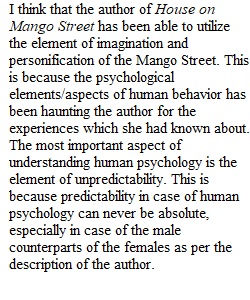


Q House on Mango Street uses a number of literary techniques that reflect the progression in consciousness within the text. First, it’s a bildungsroman or coming-of-age narrative, so we witness the internal growth as Esperanza processes the human experiences around her and their implications for her own identity. The book is also a series of vignettes, so it’s really a collection of several short stories that are connected by the nature of the community and the character of the experiences being narrated. Then there is the setting, Mango Street, in relation to the rest of the city or the world. Mango Street is in part defined by the cultural heritage of its residents as well as their economic circumstances. So, it’s a refuge of sorts, but it’s not isolated from the world. Thus, Cisneros’s text in some ways exemplifies the cultural-linguistic-oral/literary borderland that Anzaldua writes about. Some critics have condemned Cisneros for promoting stereotypes about Mexican-American men (as wife-beaters, for instance), but House on Mango Street apparently aims beyond that. As Esperanza narrates and reflects, using concrete imagery that can be explained both by her age and her connection to the experiences, she seems to realize that identity is progressively complex: she may be able to leave Mango Street physically, but there is also a Mango Street of the mind (so to speak) that will probably always be a part of her.
View Related Questions